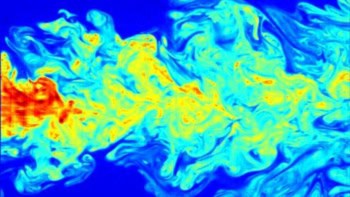
Striking evidence that string theory could be the sole viable “theory of everything” has emerged in a new theoretical study of particle scattering that was done by a trio of physicists in the US. By unifying all fundamental forces of nature, including gravity, string theory could provide the long-sought quantum description of gravity that has eluded scientists for decades.
The research was done by Caltech’s Clifford Cheung and Aaron Hillman along with Grant Remmen at New York University. They have delved into the intricate mathematics of scattering amplitudes, which are quantities that encapsulate the probabilities of particles interacting when they collide.
Through a novel application of the bootstrap approach, the trio demonstrated that imposing general principles of quantum mechanics uniquely determines the scattering amplitudes of particles at the smallest scales. Remarkably, the results match the string scattering amplitudes derived in earlier works. This suggests that string theory may indeed be an inevitable description of the universe, even as direct experimental verification remains out of reach.
“A bootstrap is a mathematical construction in which insight into the physical properties of a system can be obtained without having to know its underlying fundamental dynamics,” explains Remmen. “Instead, the bootstrap uses properties like symmetries or other mathematical criteria to construct the physics from the bottom up, ‘effectively pulling itself up by its bootstraps’. In our study, we bootstrapped scattering amplitudes, which describe the quantum probabilities for the interactions of particles or strings.”
Why strings?
String theory posits that the elementary building blocks of the universe are not point-like particles but instead tiny, vibrating strings. The different vibrational modes of these strings give rise to the various particles observed in nature, such as electrons and quarks. This elegant framework resolves many of the mathematical inconsistencies that plague attempts to formulate a quantum description of gravity. Moreover, it unifies gravity with the other fundamental forces: electromagnetic, weak, and strong interactions.
However, a major hurdle remains. The characteristic size of these strings is estimated to be around 10−35 m, which is roughly 15 orders of magnitude smaller than the resolution of today’s particle accelerators, including the Large Hadron Collider. This makes experimental verification of string theory extraordinarily challenging, if not impossible, for the foreseeable future.
Faced with the experimental inaccessibility of strings, physicists have turned to theoretical methods like the bootstrap to test whether string theory aligns with fundamental principles. By focusing on the mathematical consistency of scattering amplitudes, the researchers imposed constraints based on basic quantum mechanical requirements on the scattering amplitudes such as locality and unitarity.
“Locality means that forces take time to propagate: particles and fields in one place don’t instantaneously affect another location, since that would violate the rules of cause-and-effect,” says Remmen. “Unitarity is conservation of probability in quantum mechanics: the probability for all possible outcomes must always add up to 100%, and all probabilities are positive. This basic requirement also constrains scattering amplitudes in important ways.”
In addition to these principles, the team introduced further general conditions, such as the existence of an infinite spectrum of fundamental particles and specific high-energy behaviour of the amplitudes. These criteria have long been considered essential for any theory that incorporates quantum gravity.
Unique solution
Their result is a unique solution to the bootstrap equations, which turned out to be the Veneziano amplitude — a formula originally derived to describe string scattering. This discovery strongly indicates that string theory meets the most essential criteria for a quantum theory of gravity. However, the definitive answer to whether string theory is truly the “theory of everything” must ultimately come from experimental evidence.
Cheung explains, “Our work asks: what is the precise math problem whose solution is the scattering amplitude of strings? And is it the unique solution?”. He adds, “This work can’t verify the validity of string theory, which like all questions about nature is a question for experiment to resolve. But it can help illuminate whether the hypothesis that the world is described by vibrating strings is actually logically equivalent to a smaller, perhaps more conservative set of bottom up assumptions that define this math problem.”
The trio’s study opens up several avenues for further exploration. One immediate goal for the researchers is to generalize their analysis to more complex scenarios. For instance, the current work focuses on the scattering of two particles into two others. Future studies will aim to extend the bootstrap approach to processes involving multiple incoming and outgoing particles.
Another direction involves incorporating closed strings, which are loops that are distinct from the open strings analysed in this study. Closed strings are particularly important in string theory because they naturally describe gravitons, the hypothetical particles responsible for mediating gravity. While closed string amplitudes are more mathematically intricate, demonstrating that they too arise uniquely from the bootstrap equations would further bolster the case for string theory.
The research is described in Physical Review Letters.



